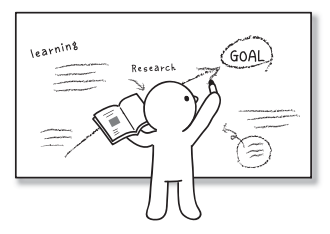Difference between revisions of "Design Your Learning/OG"
Jump to navigation
Jump to search
The Learning Patterns help you improve your way of learning, and help you build an active community of learners.
***
▼In this context
▼Therefore
Sfrancisco (talk | contribs) (Added category) |
Sfrancisco (talk | contribs) m (Edited format) |
||
| (One intermediate revision by the same user not shown) | |||
| Line 5: | Line 5: | ||
|image= <!-- Provide the filename of the image to be displayed (e.g., Design_pattern.png) --> | |image= <!-- Provide the filename of the image to be displayed (e.g., Design_pattern.png) --> | ||
|contributor= [[Takashi Iba]], [[Mami Sakamoto]] | |contributor= [[Takashi Iba]], [[Mami Sakamoto]] | ||
|source= Iba & Sakamoto (2011)<ref>Iba, T., & Sakamoto, M. (2011). [http://dl.acm.org/citation.cfm?doid=2578903.2579166 Learning patterns III: a pattern language for creative learning]. In ''Proceedings of the 18th Conference on Pattern Languages of Programs | |source= Iba & Sakamoto (2011)<ref>Iba, T., & Sakamoto, M. (2011). [http://dl.acm.org/citation.cfm?doid=2578903.2579166 Learning patterns III: a pattern language for creative learning]. In ''Proceedings of the 18th Conference on Pattern Languages of Programs (PLoP 2011)'' (p. 29). New York:ACM.</ref> | ||
|dataanalysis= <!-- If applicable, list of data analyses used for mining the pattern separated by a " , "comma --> | |dataanalysis= <!-- If applicable, list of data analyses used for mining the pattern separated by a " , "comma --> | ||
|domain= <!-- Learning domain the design pattern belongs to (e.g., General, Math, Algebra) --> | |domain= <!-- Learning domain the design pattern belongs to (e.g., General, Math, Algebra) --> | ||
| Line 15: | Line 15: | ||
Also Known As: {{Patternlink|Learning Design}}<ref>Iba, T., & Miyake, T. (2010). [http://dl.acm.org/citation.cfm?doid=2371736.2371742 Learning Patterns: a pattern language for creative learning II]. In ''Proceedings of the 1st Asian Conference on Pattern Languages of Programs'' (p. 4). | Also Known As: {{Patternlink|Learning Design}}<ref>Iba, T., & Miyake, T. (2010). [http://dl.acm.org/citation.cfm?doid=2371736.2371742 Learning Patterns: a pattern language for creative learning II]. In ''Proceedings of the 1st Asian Conference on Pattern Languages of Programs'' (p. 4). New York:ACM.</ref> | ||
| Line 60: | Line 60: | ||
<references/> | <references/> | ||
[[Category:Design_patterns]] [[Category:Full_Pattern]]<!-- List of other categories the design pattern belongs to. The syntax for linking to a category is: [[Category:<Name of category]] --> | [[Category:Design_patterns]] [[Category:Full_Pattern]] [[Category:Creative Education Patterns]] [[Category:Traditional Classroom]]<!-- List of other categories the design pattern belongs to. The syntax for linking to a category is: [[Category:<Name of category]] --> | ||
Latest revision as of 12:57, 17 May 2017
| Design Your Learning | |
| Contributors | Takashi Iba, Mami Sakamoto |
|---|---|
| Last modification | May 17, 2017 |
| Source | Iba & Sakamoto (2011)[1] |
| Pattern formats | OPR Alexandrian |
| Usability | |
| Learning domain | |
| Stakeholders | |
Also Known As: Learning Design (Learning Design)[2]
“Design is not just what it looks like and feels like. Design is how it works.” — Steve Jobs
“The limits of my language mean the limits of my world.” — Ludwig Wittgenstein
“It is not knowledge, but the means of gaining knowledge which I have to teach.” — Thomas Arnold
You’ve recognized that continual learning is an essential activity in a complex and fluid society.
It is not easy to learn how to learn.
- • There are several ways of learning.
- • It is unrealistic to try many ways of learning because time is limited.
- • It is quite difficult even for experts to explain their tacit knowledge.
Learn the way of learning from the Learning Patterns, which help you achieve good methods for learning.
- • Read through all patterns to understand what the Learning Patterns are like, especially the first half of each pattern, namely a pattern name, an introductory sentence and illustration, and quotes.
- • Read the detail of each pattern in which you are interested. In the second half of each pattern, there are descriptions about a context, a problem, forces (difficulties why the problem is hard to solve), a solution, and actions (how to solve problems in practice).
- • Read the patterns in order to recognize the problem that may easily occur in the context where you are.
- • When you face a problem in learning, find the corresponding patterns to find the solution to it.
- • When you talk about the way of learning, use the pattern name of the Learning Patterns as the term of a common language for learning.
References
- ↑ Iba, T., & Sakamoto, M. (2011). Learning patterns III: a pattern language for creative learning. In Proceedings of the 18th Conference on Pattern Languages of Programs (PLoP 2011) (p. 29). New York:ACM.
- ↑ Iba, T., & Miyake, T. (2010). Learning Patterns: a pattern language for creative learning II. In Proceedings of the 1st Asian Conference on Pattern Languages of Programs (p. 4). New York:ACM.
